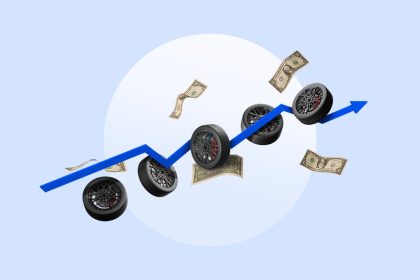Key takeaways
- It is generally best to avoid 84-month loans, but they might be helpful in certain situations.
- An 84-month auto loan generally has lower monthly payments but higher total borrowing costs.
- Before you take out an 84-month car loan, explore all of your options, including waiting until you can afford a higher down payment.
An 84-month auto loan, which stretches the repayment period to seven years, is becoming more common as the average new car price has increased. Almost 20 percent of new car buyers selected 84-month terms in Q1 of 2025, according to Edmunds.
Ivan Drury, director of insights at Edmunds, says choosing an 84-month term is the easiest way for consumers to lower their auto loan’s monthly payment to make them more manageable. “As vehicles become increasingly more expensive, [84-month auto loans] will be used more often,” he says.
That said, before you take out an 84-month auto loan, it’s crucial to understand the drawbacks, such as paying more interest over the life of the loan. It is also essential to consider alternatives, such as opting for a lower-priced vehicle with a shorter term.
Tariffs and car prices pose challenges for consumers
With rising car costs, Bankrate writer Brittany Howard shows how car buyers are strategizing their next car purchase.
Read more
Why you should avoid 84-month auto loans
Although a longer auto loan term means a lower monthly payment, it could be trouble later on. Here are some potential pitfalls to watch out for:
1. Longer terms are more expensive
While your monthly payments will be lower with a longer term, the total interest charged will be higher. For example, consider a $40,000 auto loan with a 7 percent interest rate. If you were to opt for a 60-month repayment term, your monthly payment would be $792. Extend that term to 84 months, though, and your monthly payment drops to $604.
| Loan term | Monthly payment | Total interest paid |
|---|---|---|
| 60 months | $792 | $7,523 |
| 84 months | $604 | $10,711 |
You would save almost $200 each month with an 84-month term, but it means you will pay significantly more overall. A 60-month auto loan costs $7,523 in interest. Since there is more time for interest to accumulate, an 84-month term can be much more expensive. The total interest you pay with a longer term is $10,711 – over $3,000 more than a 60-month auto loan term.
2. Depreciation causes extra risk
On average, a new car can lose 30 percent of its value within the first two years after you purchase it, and it will continue to lose 8 to 12 percent of its value each year after that, according to Kelley Blue Book.
According to Zander Cook, co-founder of Lease End, a longer loan term often means you have a higher chance of having negative equity, or being upside down on your car loan, meaning you owe more on the loan than the car is worth.
If the interest rate is high or the car depreciates quickly, an 84-month loan can put you upside down fast. Vehicles with steep depreciation curves, like a Dodge Journey, can leave you owing more than the car is worth within the first year or two, which is risky if you need to sell or trade in early.
— Zander Cook, co-founder of Lease End
Selling or trading a car that you’re upside-down on can lead to a cycle of negative equity if you roll over your current auto loan into the next one. “You’re going to be paying for that other car [plus interest] that you don’t even own anymore,” says Drury.
3. Potential repair issues
The older the car, the more costly the repairs are. With an 84-month term, there’s a much higher chance that you’ll need to decide whether to replace or repair your vehicle while paying back the loan. If you have a tight budget and low emergency reserves, it could put a big strain on your budget.
4. More time spent out of warranty
There are some new cars that offer long warranties, but most are three years or 36,000 miles. With an 84-month loan, you’ll still be paying off your car long after the warranty ends. Try to avoid an auto loan term that exceeds the length of your car’s warranty.
If you’re getting a used car, you likely won’t have a warranty to worry about. This makes expected depreciation and average repair costs even more important – so don’t skimp on research. Kelley Blue Book and Edmunds both have estimates on the total cost to own that go beyond general repairs covered by a warranty.
When to consider an 84-month auto loan
Getting an 84-month auto loan could be an excellent choice if you plan on paying off the loan early or refinancing to a shorter term in the future. There are also circumstances where an 84-month loan makes sense if you have a tight budget or don’t have a lot of room to negotiate with a car dealer. When you have limited choices, a long-term auto loan may be the best option.
“If you’re buying a vehicle known for retaining its value, like a Ford Raptor, an 84-month loan can be a smart move,” says Cook.
1. You’re on a tight budget
Seven years is a long time, and it means you can borrow more money and still have a relatively low monthly payment. If you have a tight budget, an 84-month term may help keep month-to-month costs down, but you will pay more interest overall.
2. You plan to refinance
If you aren’t able to afford a higher monthly payment, you can always take a longer repayment term at the start and refinance to a lower rate when your budget – and credit score – allows. If your lender doesn’t charge a prepayment fee, you can also pay off your loan early and save money on interest.
3. You qualify for competitive rates
If you have a good or excellent credit score, you may qualify for very competitive loan rates, making an 84-month auto loan more appealing. If you have stellar credit, you may even qualify for a 0% APR loan. These types of loans are typically available through manufacturer-owned, captive finance companies and are reserved for new or certified pre-owned (CPO models) purchases.
4. You want a more reliable car
New cars and recent model used cars are generally more expensive, but the cost can be worth it if it means you have a safer, more reliable vehicle. With a more reliable car, you will likely have less expensive maintenance costs initially. Many issues may be covered under the vehicle’s warranty while it lasts, though as with the drawbacks, you will spend years paying for a car while it is no longer under warranty.
How to choose an auto loan term length
The biggest mistake is choosing a long-term loan for the wrong car. “If the vehicle loses value too quickly, you’ll be underwater for years,” says Cook. “The way to avoid this is to focus on both the car’s depreciation rate and the loan structure, choose a simple interest loan on a car that holds value, and aim to pay it down faster when possible.”
It’s not uncommon for dealers to use sales tricks that are meant to convince you into a longer term, but you can visit the dealership prepared for common tactics. When selecting your repayment term, consider the amount you’re financing, the interest rate and your budget.
- Assess your financial situation: As you consider auto loans, keep your current financial situation, needs and long-term goals in mind. An 84-month loan cuts down on your monthly payment, but you could also opt for a less expensive vehicle to save money.
- Understand current interest rates: Research market rates and rate offers from lenders so that you can gauge what the loan will likely cost you. Lenders tend to offer more competitive rates for shorter terms, but lenders will also use your credit score to determine rates.
- Evaluate monthly payments: Compare the monthly payments available between an 84-month loan and shorter terms to assess what makes the most sense for you and your budget. Use an auto loan calculator to estimate your monthly payment and the overall cost of your loan.
- Compare total costs: While your monthly payments will be lower with an 84-month loan, the total cost of interest over the life of the loan will likely be substantially more compared to shorter auto loan terms.
4 Alternative auto loan options
Use an auto loan calculator to get an idea of what a longer term will cost you. If you’re not sure a longer term is right for you – even with the best 84-month auto loan rates – here are some alternatives to consider:
- Wait and save: If you’re stuck on a specific model but can’t afford it without a longer term, consider waiting to accumulate enough cash for a higher down payment. Use an auto loan down payment calculator to see how much it can reduce your monthly payment.
- Opt for a cheaper car: If you don’t have time to save for a larger down payment, consider changing your expectations to a less expensive vehicle that allows you to finance for a shorter term.
- Find room in your budget: If you haven’t already, take a look at your income and expenses for the last few months and determine if there are areas where you can cut back to make room for a higher monthly payment.
- Lease instead of buying: Leases have shorter terms than auto loans on average – two to four years, according to the Consumer Financial Protection Bureau. Despite the shorter term, leases tend to be less expensive and have lower monthly payments because they are based on the vehicle’s depreciation and not its sales price.
Bottom line
Although an 84-month car loan will result in smaller monthly payments, you’ll ultimately pay more in interest. You also risk owing more on the loan than your car is worth and potentially incurring large repair bills. Before choosing a longer auto loan term, consider a shorter term to save more overall.
And remember to compare as many lenders as possible to increase your chances of qualifying for the best auto loan rate for your financial situation.
Why we ask for feedback
Your feedback helps us improve our content and services. It takes less than a minute to
complete.
Your responses are anonymous and will only be used for improving our website.
Help us improve our content
Read the full article here
















